Abstract
The few geneticists who are interested in leprosy have been working in this field only since 1962, and have made little progress in solving the problems presented by susceptibility to this disease.
This paper reviews the research that has been conducted, with particular reference to the search for associations between leprosy and certain genetic markers. In each area, the advantages and limitations of different techniques are described, and attention is drawn to sources of bias that may invalidate many of the results that have been published. Of particular interest is the discussion of a new technique for evaluating resistance to-leprosy. The proposed technique is based upon the in vitro transformation of blood monocytes into macrophages, and the observation of their behaviour against Mycobacterium leprae.
Full text
PDF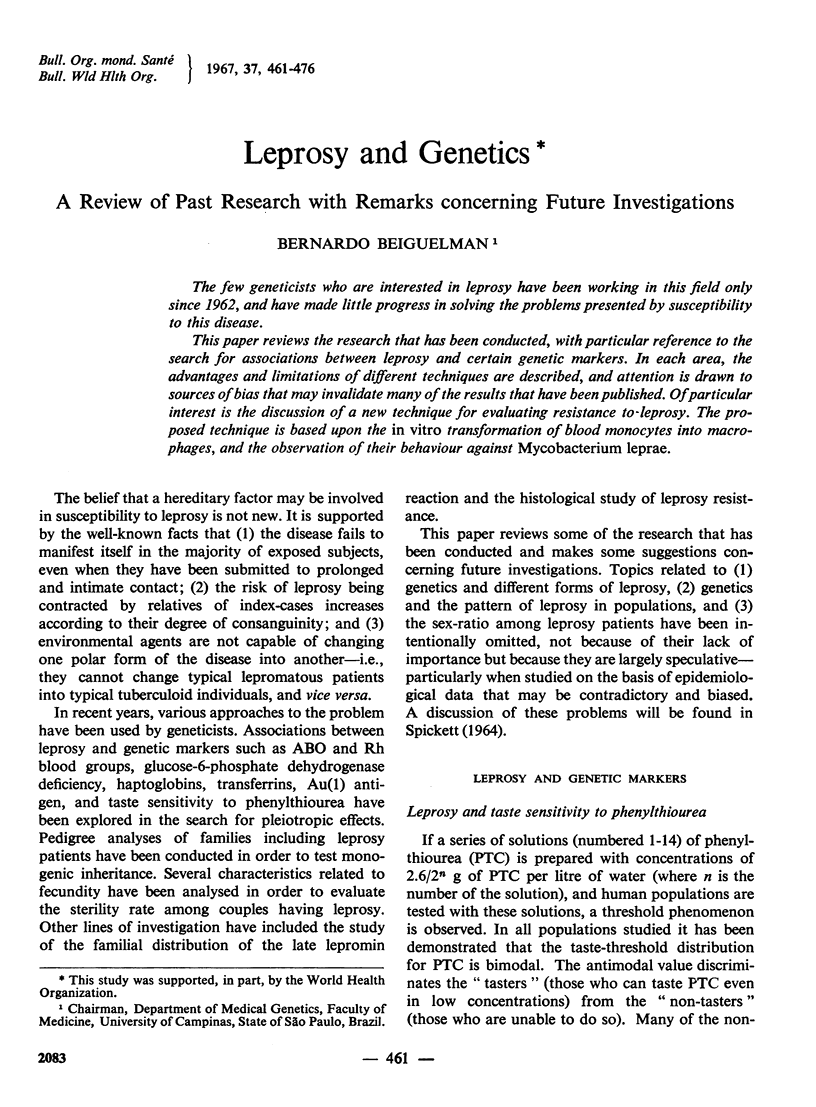

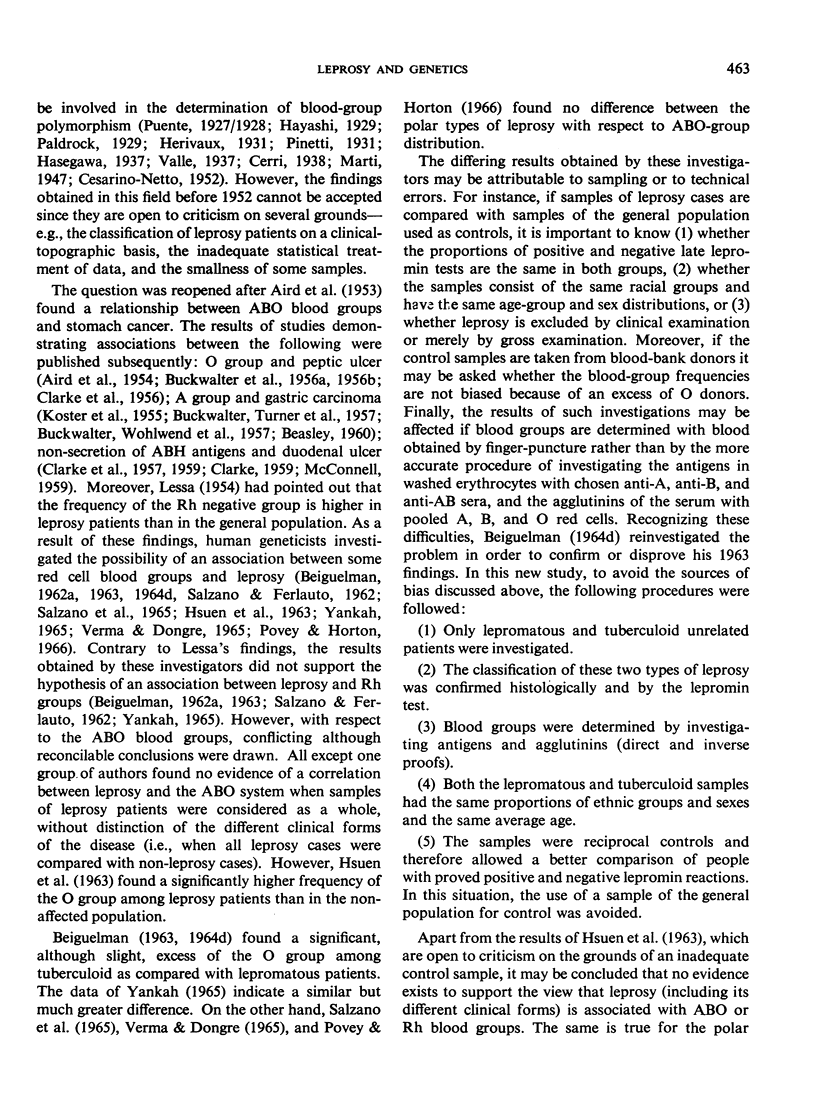
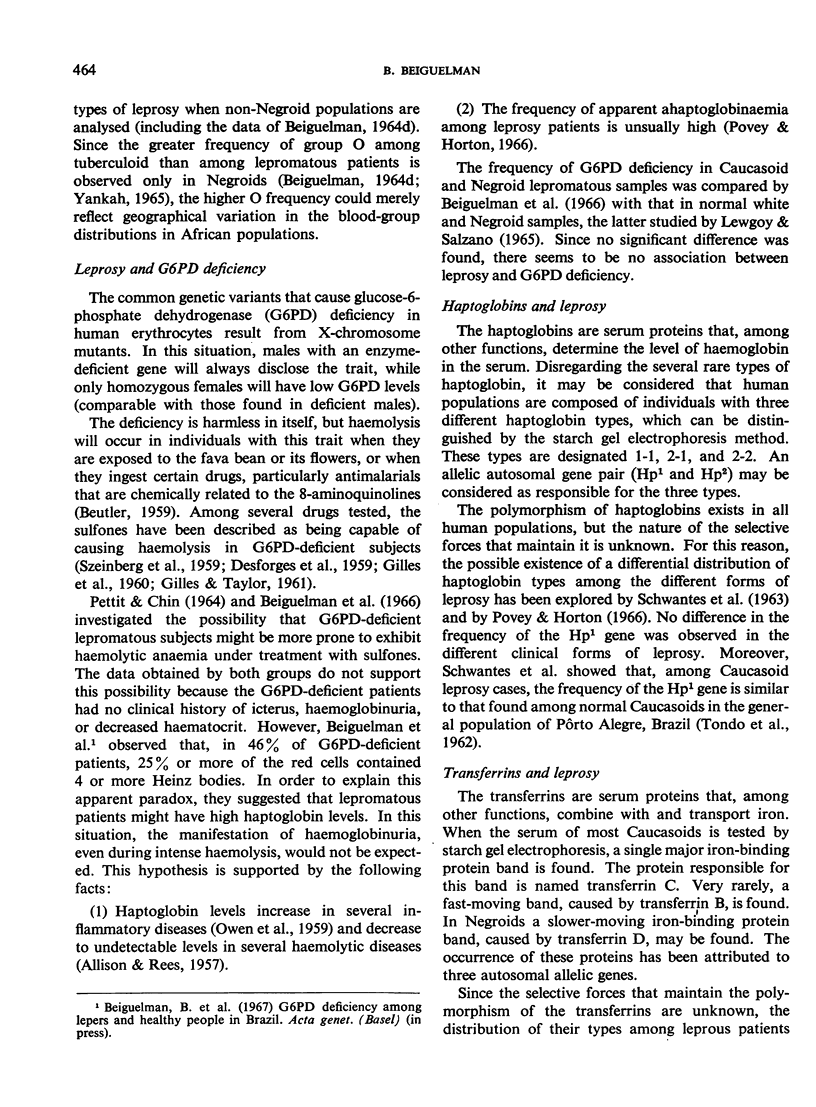
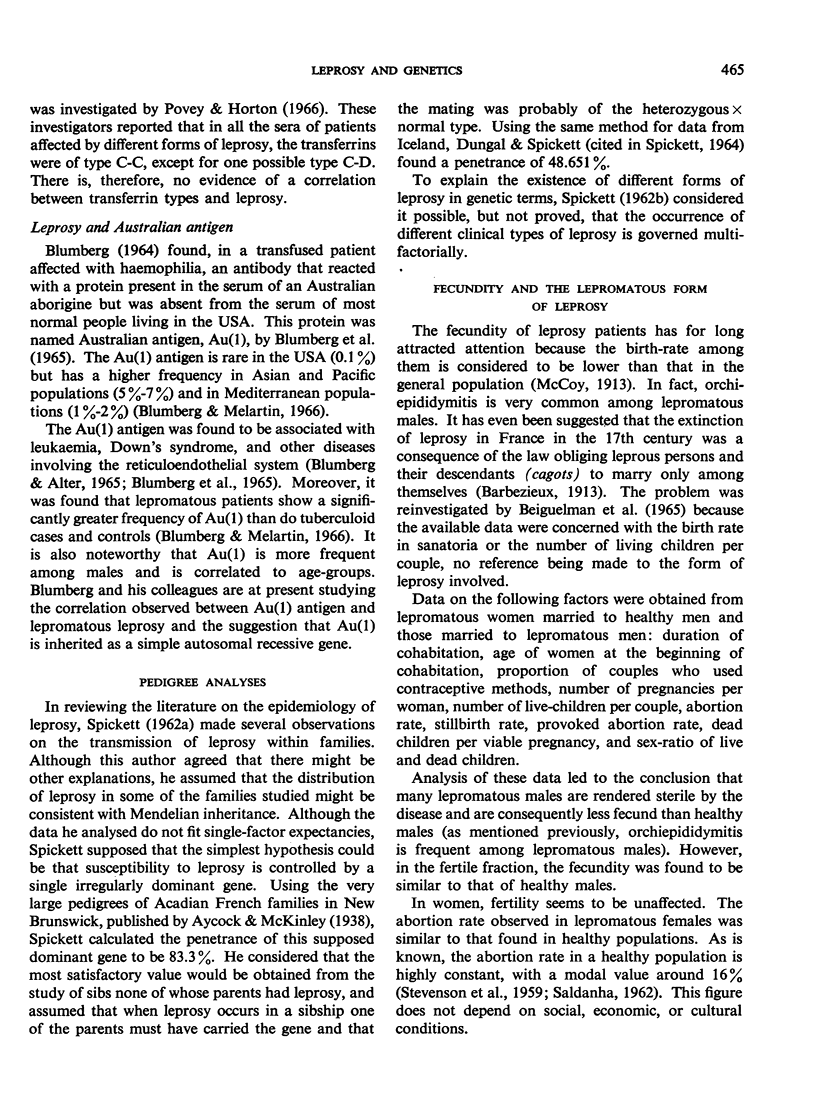
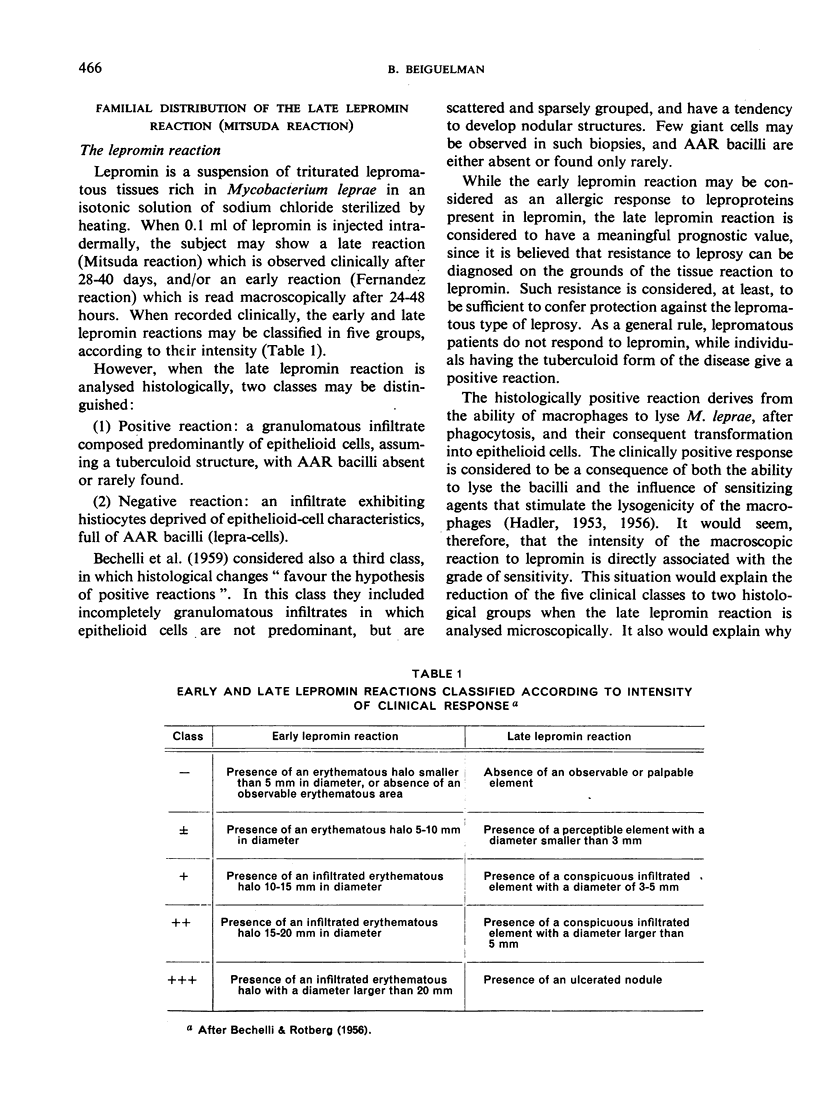
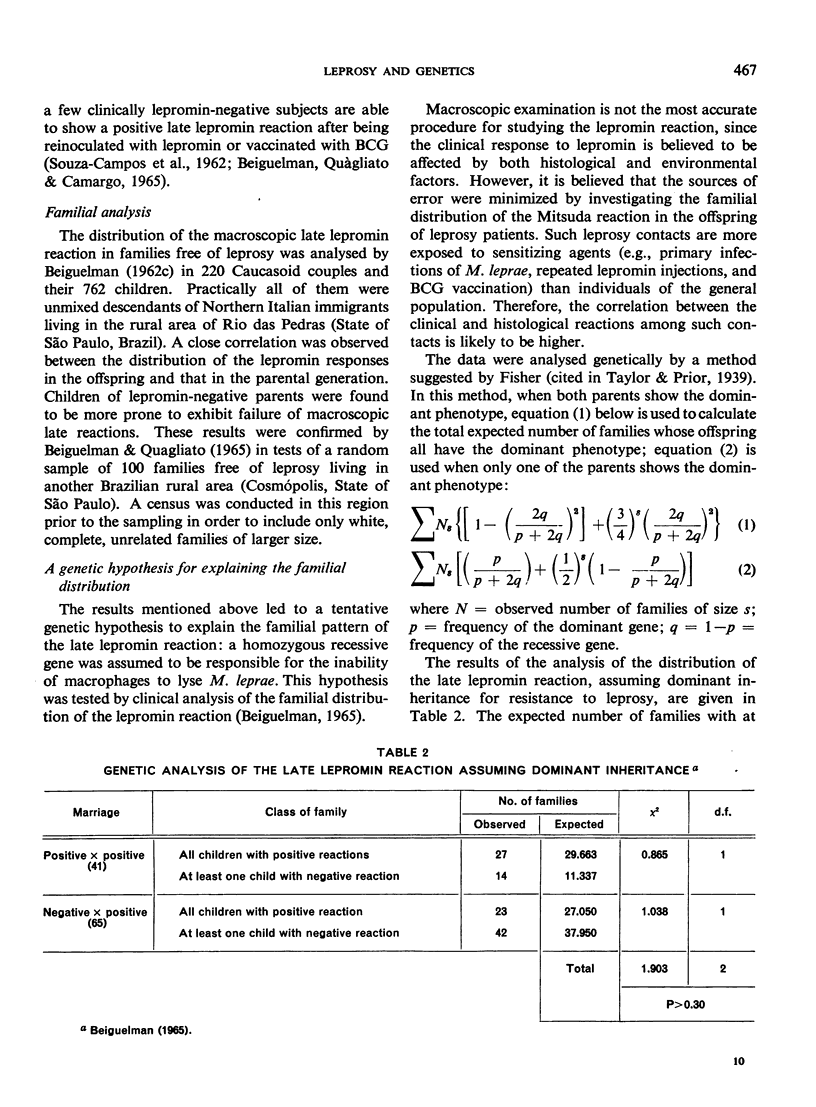
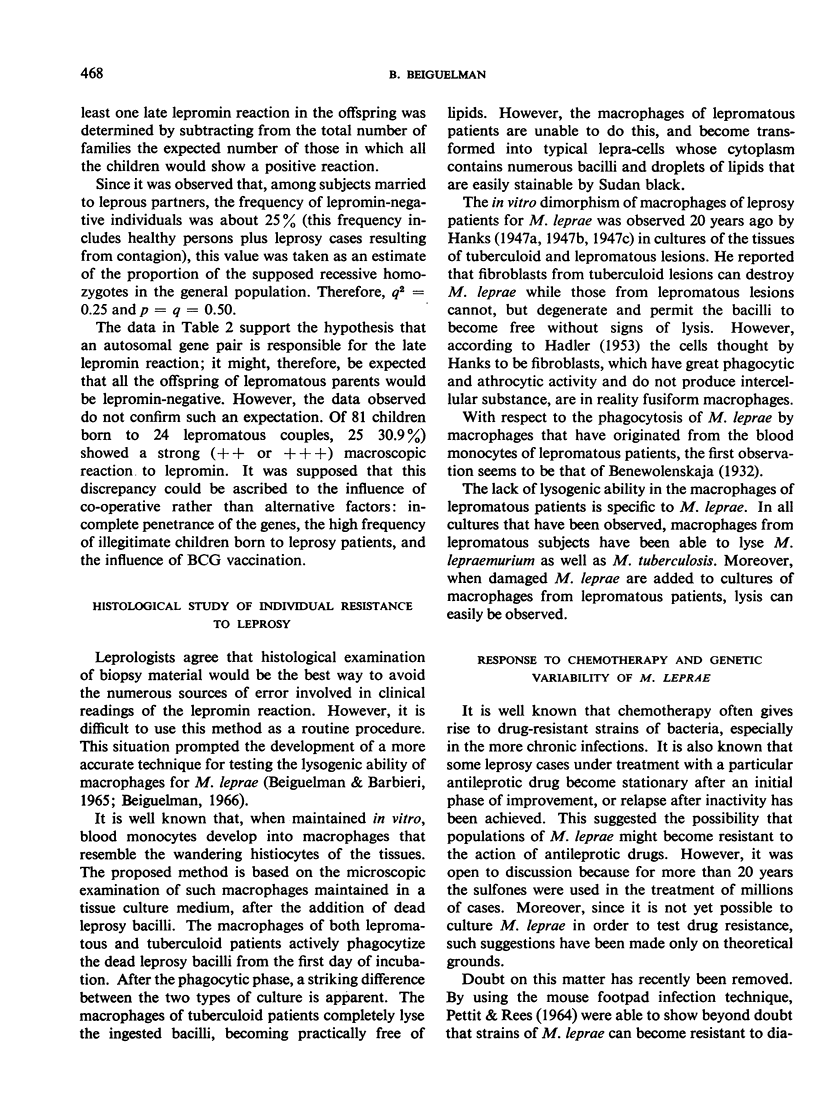
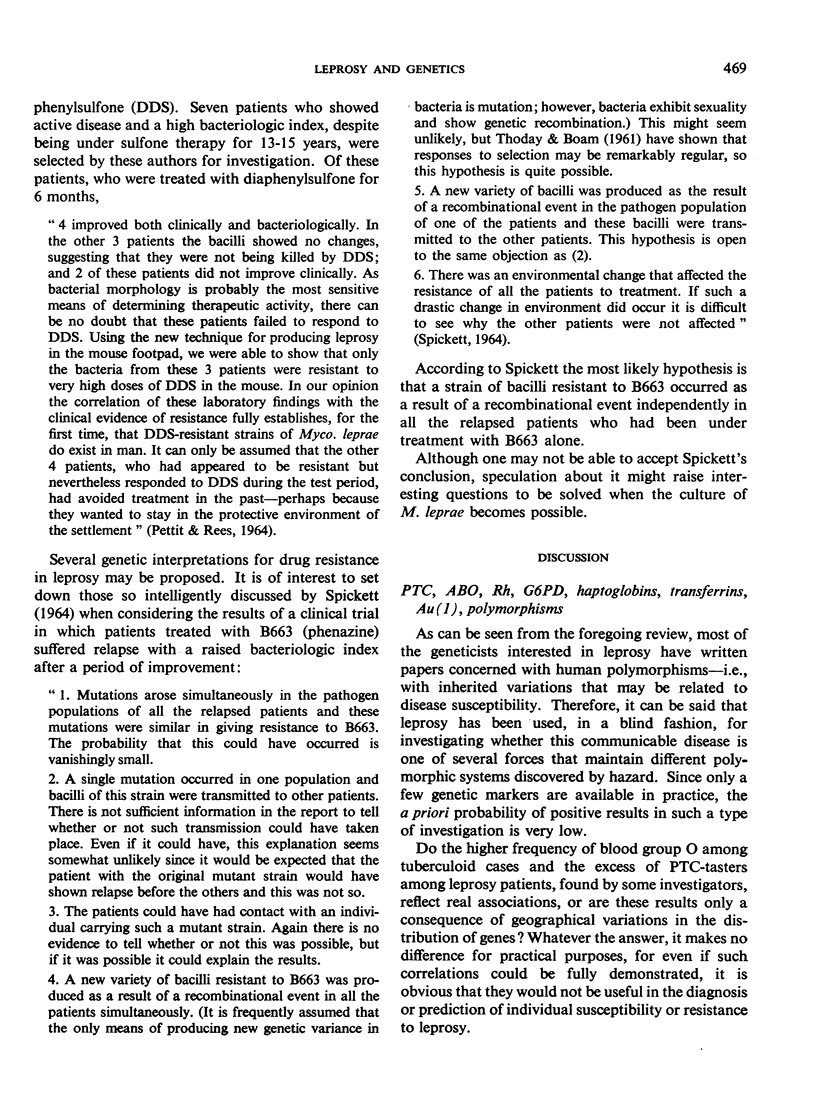
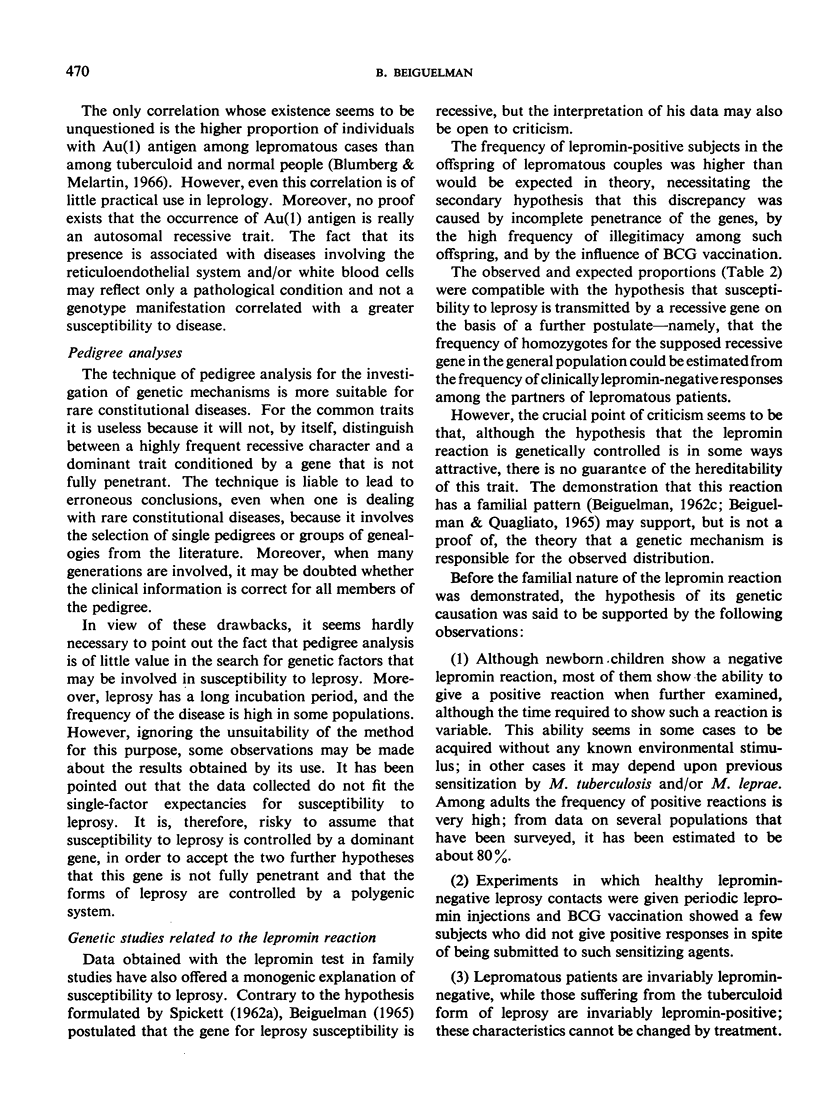
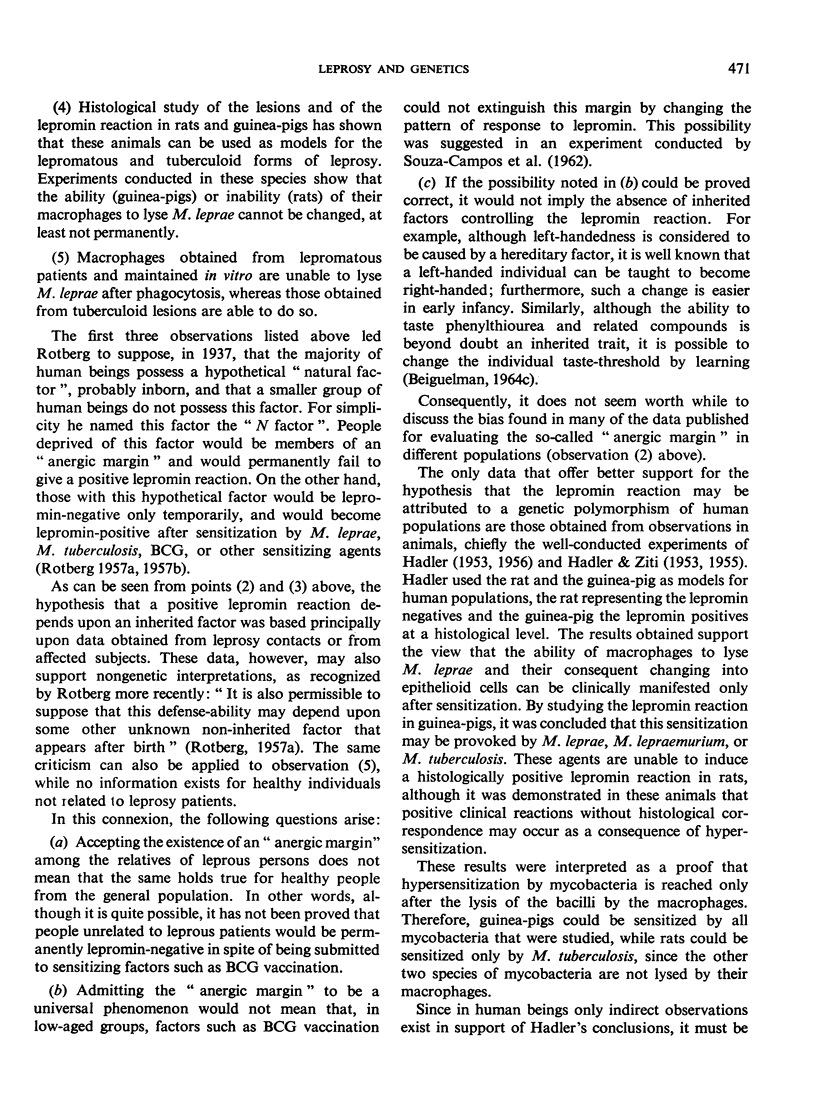
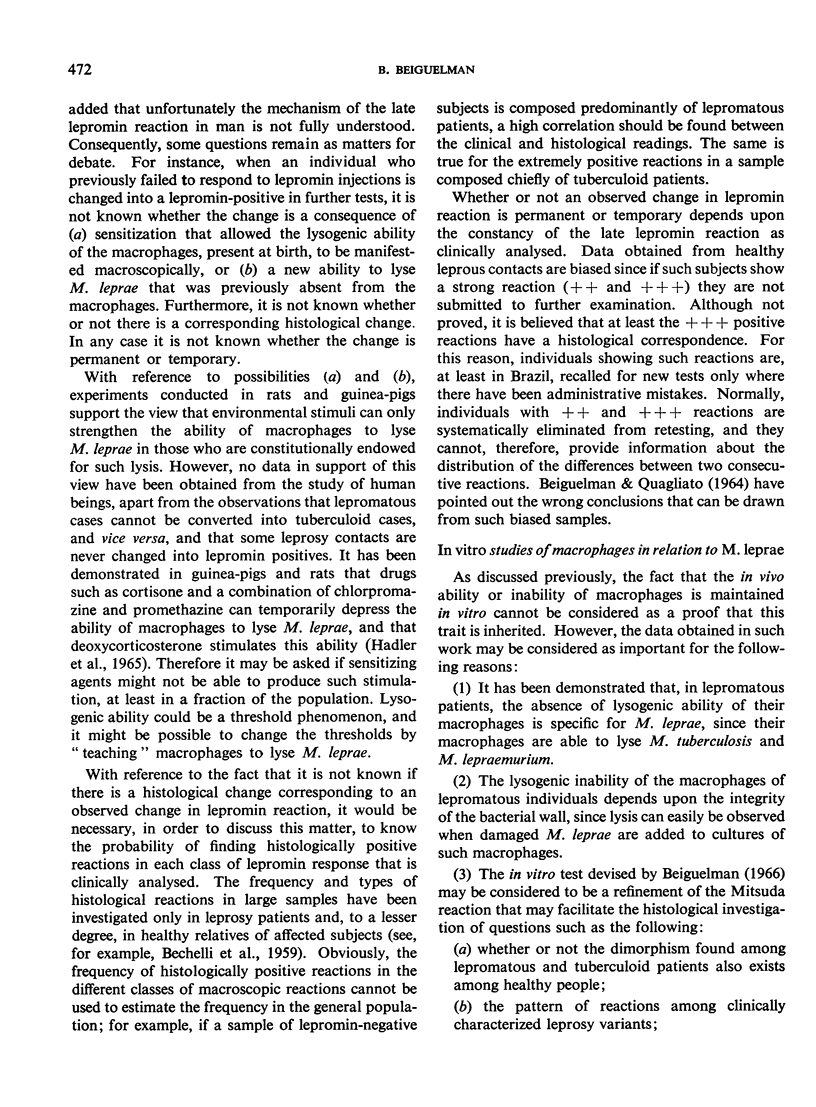
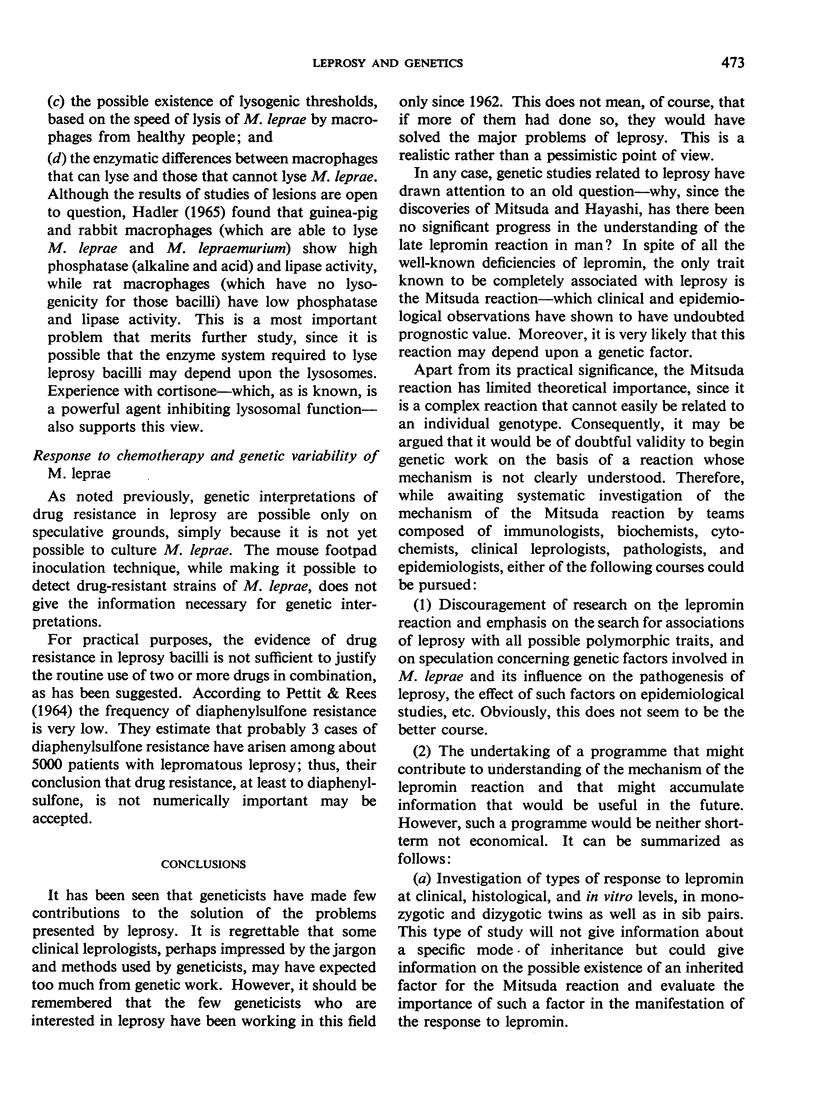
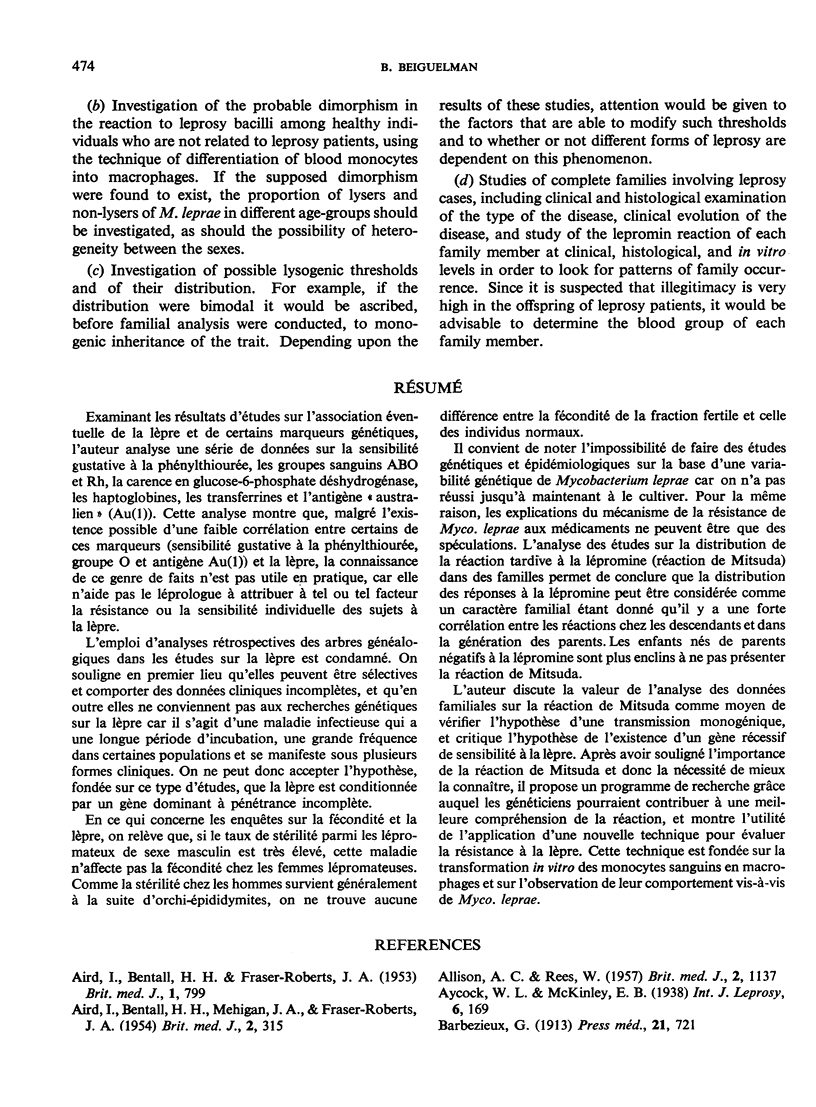
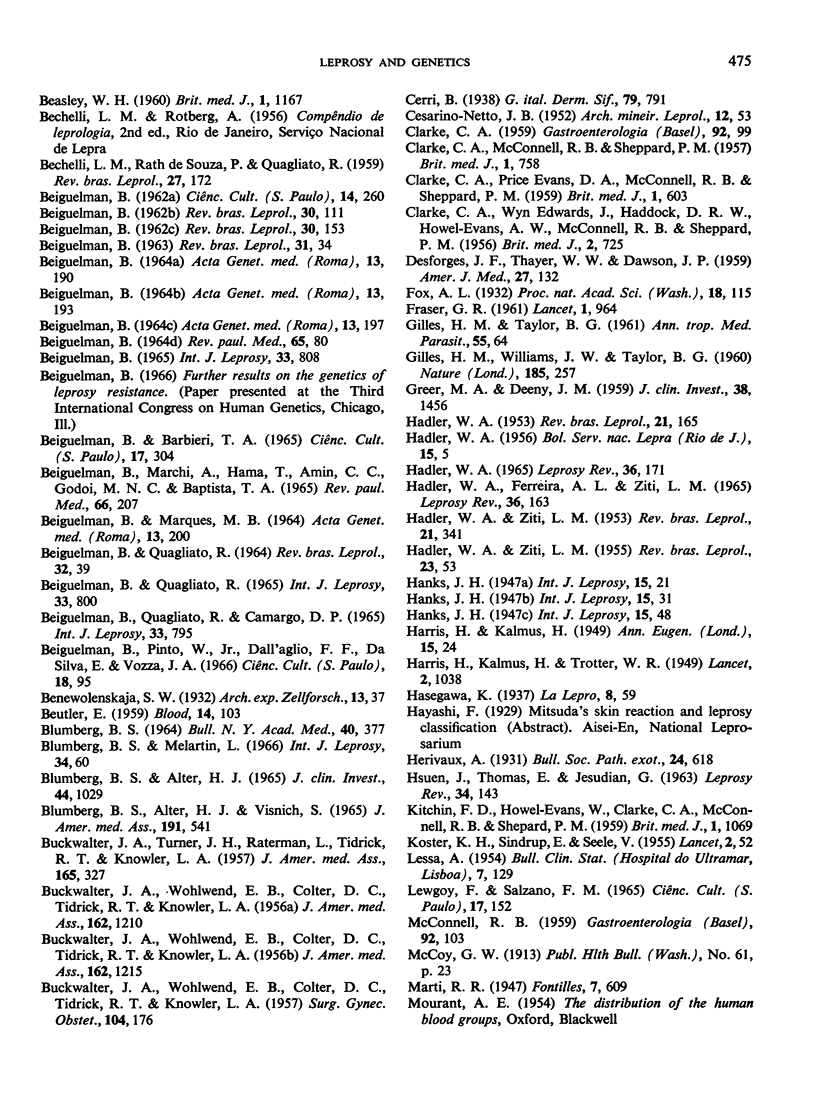
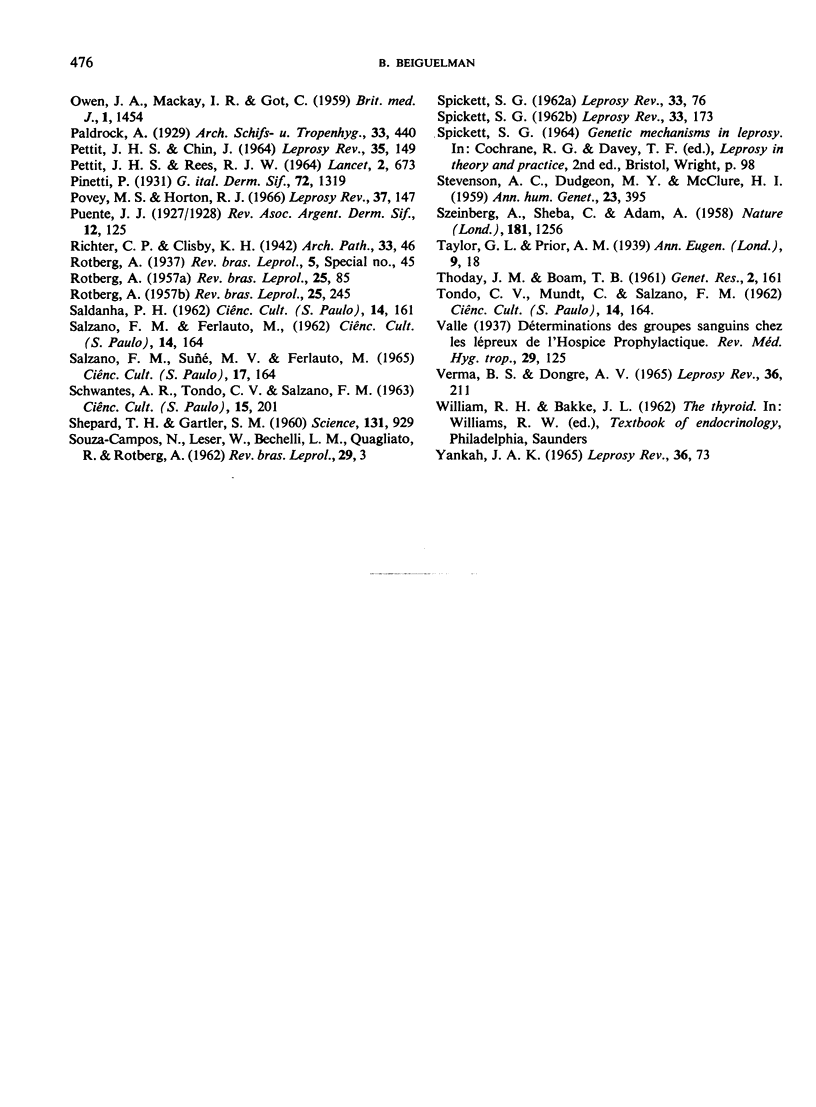
Selected References
These references are in PubMed. This may not be the complete list of references from this article.
- AIRD I., BENTALL H. H., MEHIGAN J. A., ROBERTS J. A. F. The blood groups in relation to peptic ulceration and carcinoma of colon, rectum, breast, and bronchus; an association between the ABO groups and peptic ulceration. Br Med J. 1954 Aug 7;2(4883):315–321. doi: 10.1136/bmj.2.4883.315. [DOI] [PMC free article] [PubMed] [Google Scholar]
- AIRD I., BENTALL H. H., ROBERTS J. A. F. A relationship between cancer of stomach and the ABO blood groups. Br Med J. 1953 Apr 11;1(4814):799–801. doi: 10.1136/bmj.1.4814.799. [DOI] [PMC free article] [PubMed] [Google Scholar]
- ALLISON A. C., REES W. A. The binding of haemoglobin by plasma proteins (haptoglobins); its bearing on the renal threshold for haemoglobin and the aetiology of haemoglobinuria. Br Med J. 1957 Nov 16;2(5054):1137–1143. doi: 10.1136/bmj.2.5054.1137. [DOI] [PMC free article] [PubMed] [Google Scholar]
- BEASLEY W. H. Blood groups of gastric ulcer and carcinoma. Br Med J. 1960 Apr 16;1(5180):1167–1172. doi: 10.1136/bmj.1.5180.1167. [DOI] [PMC free article] [PubMed] [Google Scholar]
- BECHELLI L. M., de SOUZA P., QUAGLIATO R. [Correlation between the results of the clinical reading and histopathological examination of the Mitsuda reaction]. Rev Bras Leprol. 1959 Oct-Dec;27:172–182. [PubMed] [Google Scholar]
- BEIGUELMAN B. GRUPOS SANGUE'INEOS E LEPRA. Rev Bras Leprol. 1963 Jan-Jun;31:34–44. [PubMed] [Google Scholar]
- BEIGUELMAN B., MARQUES M. B. TASTE SENSITIVITY TO PHENYLTHIOUREA AND DRUGS WITH ANTI-LEPROTIC EFFECT. Acta Genet Med Gemellol (Roma) 1964 Apr;13:200–202. doi: 10.1017/s1120962300015845. [DOI] [PubMed] [Google Scholar]
- BEIGUELMAN B. TASTE SENSITIVITY TO PHENYLTHIOUREA AMONG PATIENTS AFFECTED WITH BOTH TUBERCULOSIS AND LEPROSY. Acta Genet Med Gemellol (Roma) 1964 Apr;13:190–192. doi: 10.1017/s112096230001581x. [DOI] [PubMed] [Google Scholar]
- BEIGUELMAN B. TASTE SENSITIVITY TO PHENYLTHIOUREA AND LEPROSY. Acta Genet Med Gemellol (Roma) 1964 Apr;13:193–196. doi: 10.1017/s1120962300015821. [DOI] [PubMed] [Google Scholar]
- BEIGUELMAN B. TASTE SENSITIVITY TO PHENYLTHIOUREA AND MENSTRUATION. Acta Genet Med Gemellol (Roma) 1964 Apr;13:197–199. doi: 10.1017/s1120962300015833. [DOI] [PubMed] [Google Scholar]
- BEUTLER E. The hemolytic effect of primaquine and related compounds: a review. Blood. 1959 Feb;14(2):103–139. [PubMed] [Google Scholar]
- BLUMBERG B. S., ALTER H. J., VISNICH S. A "NEW" ANTIGEN IN LEUKEMIA SERA. JAMA. 1965 Feb 15;191:541–546. doi: 10.1001/jama.1965.03080070025007. [DOI] [PubMed] [Google Scholar]
- BLUMBERG B. S. POLYMORPHISMS OF THE SERUM PROTEINS AND THE DEVELOPMENT OF ISO-PRECIPITINS IN TRANSFUSED PATIENTS. Bull N Y Acad Med. 1964 May;40:377–386. [PMC free article] [PubMed] [Google Scholar]
- BUCKWALTER J. A., COLTER D. C., KNOWLER L. A., TIDRICK R. T., WOHLWEND E. B. ABO blood groups and disease. J Am Med Assoc. 1956 Nov 24;162(13):1210–1215. doi: 10.1001/jama.1956.02970300010005. [DOI] [PubMed] [Google Scholar]
- BUCKWALTER J. A., TURNER J. H., RATERMAN L., TIDRICK R. T., KNOWLER L. A. Ethnologic aspects of the ABO blood groups disease associations. J Am Med Assoc. 1957 Sep 28;165(4):327–329. doi: 10.1001/jama.1957.02980220011003. [DOI] [PubMed] [Google Scholar]
- BUCKWALTER J. A., WOHLWEND C. B., COLTER D. C., TIDRICK R. T., KNOWLER L. A. The association of the ABO blood groups to gastric carcinoma. Surg Gynecol Obstet. 1957 Feb;104(2):176–179. [PubMed] [Google Scholar]
- Beiguelman B., Hama T., de Godoi M. N., Marchi A., Amin C. C., Baptista T. A. Fecundidade e lepra. Rev Paul Med. 1965 Apr;66(4):207–213. [PubMed] [Google Scholar]
- Beiguelman B., Quagliato R. Nature and familial character of the lepromin reactions. Int J Lepr. 1965 Oct-Dec;33(4):800–807. [PubMed] [Google Scholar]
- Beiguelman B., Quagliato R. Sôbre a reaço de Mitsuda. Rev Bras Leprol. 1964 Jan-Dec;32(1):39–46. [PubMed] [Google Scholar]
- Beiguelman B., Quagliato R., de Camargo D. P. Influence of repeated lepromin injections on the Mitsuda skin reaction. Int J Lepr. 1965 Oct-Dec;33(4):795–799. [PubMed] [Google Scholar]
- Beiguelman B. The genetics of resistance to leprosy. Int J Lepr. 1965 Oct-Dec;33(4):808–812. [PubMed] [Google Scholar]
- Blumberg B. S., Melartin L. Conjectures on inherited susceptibility to lepromatous leprosy. Int J Lepr Other Mycobact Dis. 1966 Jan-Mar;34(1):60–64. [PubMed] [Google Scholar]
- CLARKE C. A. Distribution of ABO blood groups and the secretor status in duodenal ulcer families. Gastroenterologia. 1959;92:99–103. doi: 10.1159/000202879. [DOI] [PubMed] [Google Scholar]
- CLARKE C. A., EDWARDS J. W., HADDOCK D. R., HOWEL-EVANS A. W., MCCONNELL R. B., SHEPPARD P. M. ABO blood groups and secretor character in duodenal ulcer; population and sibship studies. Br Med J. 1956 Sep 29;2(4995):725–731. doi: 10.1136/bmj.2.4995.725. [DOI] [PMC free article] [PubMed] [Google Scholar]
- CLARKE C. A., EVANS D. A. P., McCONNELL R. B., SHEPPARD P. M. Secretion of blood group antigens and peptic ulcer. Br Med J. 1959 Mar 7;1(5122):603–607. doi: 10.1136/bmj.1.5122.603. [DOI] [PMC free article] [PubMed] [Google Scholar]
- DESFORGES J. F., THAYER W. W., DAWSON J. P. Hemolytic anemia induced by sulfoxone therapy, with investigations into the mechanisms of its production. Am J Med. 1959 Jul;27(1):132–136. doi: 10.1016/0002-9343(59)90067-1. [DOI] [PubMed] [Google Scholar]
- FRASER G. R. Cretinism and taste sensitivity to phenylthiocarbamide. Lancet. 1961 May 6;1(7184):964–965. doi: 10.1016/s0140-6736(61)91881-5. [DOI] [PubMed] [Google Scholar]
- Fox A. L. The Relationship between Chemical Constitution and Taste. Proc Natl Acad Sci U S A. 1932 Jan;18(1):115–120. doi: 10.1073/pnas.18.1.115. [DOI] [PMC free article] [PubMed] [Google Scholar]
- GILLES H. M., TAYLOR B. G. The existence of the glucose-6-phosphate dehydrogenase deficiency trait in Nigeria and its clinical implications. Ann Trop Med Parasitol. 1961 Apr;55:64–69. doi: 10.1080/00034983.1961.11686019. [DOI] [PubMed] [Google Scholar]
- GILLES H. M., WATSON-WILLIAMS J., TAYLOR B. G. Glucose-6-phosphate dehydrogenase deficiency trait in Nigeria. Nature. 1960 Jan 23;185:257–258. doi: 10.1038/185257b0. [DOI] [PubMed] [Google Scholar]
- HADLER W. A. Comportamento do cobaio e do rato, normais, injetados com "lepromina" por via intradérmica. Rev Bras Leprol. 1953 Sep;21(3):165–194. [PubMed] [Google Scholar]
- HADLER W. A., ZITI L. M. Estudo da reaço da lepromina no rato prèviamente inoculado com M. lepraemurium e com M. tuberculosis (BCG). Rev Bras Leprol. 1955 Jan-Dec;23(1-4):53–75. [PubMed] [Google Scholar]
- HADLER W. A., ZITTI L. M. Estudo da sensibilidade tuberculinica em cobaios normais inoculados experimentalmente com M. leprae, M. lepraemurium e M. tuberculosis. Rev Bras Leprol. 1953 Dec;21(4):341–364. [PubMed] [Google Scholar]
- HARRIS H., KALMUS H., TROTTER W. R. Taste sensitivity to phenylthiourea in goitre and diabetes. Lancet. 1949 Dec 3;2(6588):1038–1038. doi: 10.1016/s0140-6736(49)91605-0. [DOI] [PubMed] [Google Scholar]
- HARRIS H., KALMUS H. The measurement of taste sensitivity to phenylthiourea. Ann Eugen. 1949 Oct;15(1):24–31. doi: 10.1111/j.1469-1809.1949.tb02419.x. [DOI] [PubMed] [Google Scholar]
- HSUEN J., THOMAS E., JESUDIAN G. A, B, O, BLOOD GROUPS AND LEPROSY. Lepr Rev. 1963 Jul;34:143–147. doi: 10.5935/0305-7518.19630024. [DOI] [PubMed] [Google Scholar]
- Hadler W. A., Ferreira A. L., Ziti L. M. An attempt to stimulate and depress the functional activity of the inflammatory cells from lesions experimentally induced by M. leprae and M. lepraemurium. Lepr Rev. 1965 Oct;36(4):163–170. doi: 10.5935/0305-7518.19650034. [DOI] [PubMed] [Google Scholar]
- Hadler W. A. Some cytochemical and cytophysiological properties of the cells from tuberculoid and lepromatous lesions. Lepr Rev. 1965 Oct;36(4):171–181. doi: 10.5935/0305-7518.19650035. [DOI] [PubMed] [Google Scholar]
- KITCHIN F. D., HOWEL-EVANS W., CLARKE C. A., McCONNELL R. B., SHEPPARD P. M. P.T.C. taste response and thyroid disease. Br Med J. 1959 Apr 25;1(5129):1069–1074. doi: 10.1136/bmj.1.5129.1069. [DOI] [PMC free article] [PubMed] [Google Scholar]
- KØSTER K. H., SINDRUP E., SEELE V. ABO blood-groups and gastric acidity. Lancet. 1955 Jul 9;269(6880):52–55. doi: 10.1016/s0140-6736(55)92159-0. [DOI] [PubMed] [Google Scholar]
- OWEN J. A., MACKAY I. R. Serum haptoglobins in hepatobiliary disease. Br Med J. 1959 Jun 6;1(5135):1454–1457. doi: 10.1136/bmj.1.5135.1454. [DOI] [PMC free article] [PubMed] [Google Scholar]
- PETTIT J. H., CHIN J. DOES GLUCOSE-6-PHOSPHATE DEHYDROGENASE DEFICIENCY MODIFY THE COURSE OF LEPROSY OR ITS TREATMENT. Lepr Rev. 1964 Jul;35:149–156. doi: 10.5935/0305-7518.19640032. [DOI] [PubMed] [Google Scholar]
- PETTIT J. H., REES R. J. SULPHONE RESISTANCE IN LEPROSY. AN EXPERIMENTAL AND CLINICAL STUDY. Lancet. 1964 Sep 26;2(7361):673–674. doi: 10.1016/s0140-6736(64)92482-1. [DOI] [PubMed] [Google Scholar]
- ROTBERG A. Fator N de resistência á lepra e relaçes com a reatividade lepromínica e tuberculínica; valor duvidoso do BCG na imunizaço antileprosa. Rev Bras Leprol. 1957 Apr-Jun;25(2):85–106. [PubMed] [Google Scholar]
- ROTBERG A. Fundamentos doutrinários das correlaçes biológicas da lepra e tuberculose. Rev Bras Leprol. 1957 Oct-Dec;25(4):245–255. [PubMed] [Google Scholar]
- SHEPARD T. H., 2nd, GARTLER S. M. Increased incidence of non-tasters of phenylthiocarbamide among congenital athyreotic cretins. Science. 1960 Mar 25;131(3404):929–929. doi: 10.1126/science.131.3404.929. [DOI] [PubMed] [Google Scholar]
- SPICKETT S. G. Genetics and the epidemiology of leprosy. I. The incidence of leprosy. Lepr Rev. 1962 Apr;33:76–93. doi: 10.5935/0305-7518.19620011. [DOI] [PubMed] [Google Scholar]
- SPICKETT S. G. Genetics and the epidemiology of leprosy. II. The form of leprosy. Lepr Rev. 1962 Jul;33:173–181. doi: 10.5935/0305-7518.19620018. [DOI] [PubMed] [Google Scholar]
- STEVENSON A. C., DUDGEON M. Y., McCLURE H. I. Observations on the results of pregnancies in women resident in Belfast. II. Abortions, hydatidiform moles and ectopic pregnancies. Ann Hum Genet. 1959 Dec;23:395–414. doi: 10.1111/j.1469-1809.1959.tb01482.x. [DOI] [PubMed] [Google Scholar]
- SZEINBERG A., SHEBA C., ADAM A. Enzymatic abnormality in erythrocytes of a population sensitive to Vicia faba or haemolytic anemia induced by drugs. Nature. 1958 May 3;181(4618):1256–1256. doi: 10.1038/1811256a0. [DOI] [PubMed] [Google Scholar]
- Verma B. S., Dongre A. V. Leprosy and A.B.O. blood groups. Lepr Rev. 1965 Oct;36(4):211–213. doi: 10.5935/0305-7518.19650039. [DOI] [PubMed] [Google Scholar]
- YANKAH J. A. OBSERVATION ON THE FREQUENCY OF A.B.O. AND RH BLOOD GROUPS IN LEPROSY AND NON-LEPROSY PEOPLE IN GHANA. Lepr Rev. 1965 Apr;36:73–74. doi: 10.5935/0305-7518.19650017. [DOI] [PubMed] [Google Scholar]


